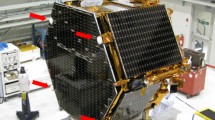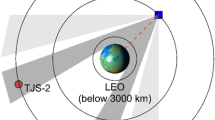Abstract
The joint Taiwan–US mission FORMOSAT-3/ COSMIC (COSMIC) was launched on April 17, 2006. Each of the six satellites is equipped with two POD antennas. The orbits of the six satellites are determined from GPS data using zero-difference carrier-phase measurements by the reduced dynamic and kinematic methods. The effects of satellite center of mass (COM) variation, satellite attitude, GPS antenna phase center variation (PCV), and cable delay difference on the COSMIC orbit determination are studied. Nominal attitudes estimated from satellite state vectors deliver a better orbit accuracy when compared to observed attitude. Numerical tests show that the COSMIC COM must be precisely calibrated in order not to corrupt orbit determination. Based on the analyses of the 5 and 6-h orbit overlaps of two 30-h arcs, orbit accuracies from the reduced dynamic and kinematic solutions are nearly identical and are at the 2–3 cm level. The mean RMS difference between the orbits from this paper and those from UCAR (near real-time) and WHU (post-processed) is about 10 cm, which is largely due to different uses of GPS ephemerides, high-rate GPS clocks and force models. The kinematic orbits of COSMIC are expected to be used for recovery of temporal variations in the gravity field.
Similar content being viewed by others
References
Balmino G (1994) Orbit choice and the theory of radial orbit error for altimetry. In: Sansó F, Rummel R(eds) Satellite altimetry in geodesy and oceanography. Lecture Notes in earth sciences, vol 50. Springer, Berlin, pp 244–317
Beutler G, Brockmann E, Gurtner W, Hugentobler U, Mervart L, Rothacher M, Verdun A (1994) Extended orbit modeling techniques at the CODE processing center of the international GPS service for geodynamics (IGS): theory and initial results. Manuscripta Geodaetica 19:367–386
Beutler G, Jäggi A, Hugentobler U, Mervart L (2006) Efficient satellite orbit modeling using pseudo-stochastic parameters. J Geod 80: 353–372
Bock H, Dach R, Hugentobler U, Schaer S, Beutler G (2004) CODE high-rate GPS satellite clock corrections, IGS workshop, Bern, Switzerland, 1–5 March 2004
Chao BF, Pavlis EC, Hwang C, Liu CC, Shum CK, Tseng CL, Yang M (2000) COSMIC: geodetic applications in improving earth’s gravity model. Terr Atm Ocean Sci 11: 365–378
Colombo O (1984) Altimetry, orbits and tides. NASA TM 86180, Greenbelt, Maryland
Ditmar P, Kuznetsov V, van der Sluijs AAV, Schrama E, Klees R (2006) DEOS_CHAMP-01C_70: a model of the Earth’s gravity field computed from accelerations of the CHAMP satellite. J Geod 79: 586–601
Gerlach Ch, Földvary L, Svehla D, Gruber Th, Wermuth M, Sneeuw N, Frommknecht B, Oberndorfer H, Peters Th, Rothacher M, Rummel R, Steigenberger P (2003) A CHAMP-only gravity field model from kinematic orbits using the energy integral. Geophys Res Lett 30(20). doi:10.1029/2003GL018025
Hugentobler U, Dach R, Fridez P, Meindl M (2005) Bernese GPS software—version 5.0. Astronomical Institute, University of Bern
Hwang C (2001) Gravity recovery using COSMIC GPS data: application of orbital perturbation theory. J Geod 75: 117–136
Jäggi A, Hugentobler U, Beutler G (2006) Pseudo-stochastic orbit modeling techniques for low-Earth orbiters. J Geod 80: 47–60
Kang Z, Tapley B, Bettadpur S, Ries J, Nagel P, Pastor R (2006) Precise orbit determination for the GRACE mission using only GPS data. J Geod 80:322–331. doi:10.1007/s00190-006-0073-5
Lee LC, Rocken C, Kursinki ER (2000) Special issue for applications of the constellation observing system for meterology, ionosphere and climate (COSMIC). Terr Atm Ocean Sci 11(1)
Leick A (2004) GPS satellite surveying, 3rd edn. Wiley, London
Liu JN, Ge MR (2003) PANDA software and its preliminary result for positioning and orbit determination. In: The fourth international symposium on GPS/GNSS, 6–8 November 2002, WHU, People’s Republic of China
Long AC, Cappellari JO, Velex CE, Fuchs AJ (eds) (1989) Goddard trajectory determination system mathematical theory. Revision 1, FDD/552-89/001
Mayer-Gürr T, Ilk KH, Eicker A, Feuchtinger M (2005) ITG-CHAMP01: a CHAMP gravity field model from short kinematical arcs of a one-year observation period. J Geod 78: 462–480
Montenbruck O, Garcia-Fernandez M, Williams J (2006) Performance comparison of semicodeless GPS receivers for LEO satellites. GPS Solut 10: 249–261. doi:10.1007/s10291-006-0025-9
Neumayer K-H, Michalak G, König R (2005) On calibrating the CHAMP on-board accelerometer and attitude quaternion processing. In: Reigber Ch, Lühr H, Schwintzer P, Wickert J(eds) Earth observation with CHAMP: results from three years in orbit. Springer, German, pp 71–76
Reubelt T, Austen G, Grafarend EW (2004) Harmonic analysis of the Earth’s gravitational field by means of semi-continuous ephemerides of a low Earth orbiting GPS-tracked satellite. Case study: CHAMP. J Geod 77(5–6): 257–278. doi:10.1007/s00190-003-0322-9
Schreiner B (2005) COSMIC GPS POD and limb antenna test report. Internal report of UCAR
Seeber G (2003) Satellite geodesy, 2nd edn. de Gruyter, Berlin
Švehla D, Rothacher M (2003) Kinematic and reduced—dynamic precise orbit determination of low Earth orbiters. EGSXXVII General Assembly, 2002, Nice, France. Adv Geosci 1: 47–56
Švehla D, Rothacher M (2004) CHAMP and GRACE in tandem: POD with GPS and K-band measurements. Joint CHAMP/GRACE science meeting, 6–8 July 2004, GeoForschungsCentrum Potsdam, Germany
Švehla D, Rothacher M (2005a) Kinematic precise orbit determination for gravity field determination. In: Sanso F(eds) IUGG General Assembly 2003, 30 June–11 July 2003, Sapporo, Japan. The proceedings of the international association of geodesy: a window on the future of geodesy, IAG, vol 128. Springer, Berlin, pp 181–188
Švehla D, Rothacher M (2005b) Kinematic positioning of LEO and GPS satellites and IGS stations on the ground. Adv Space Res 36: 376–381. doi:10.1016/j.asr.2005.04.066
Švehla D, Rothacher M (2006) Can the reference system be defined based on the LEO/GPS bi-constellation? Paper presented at the 36th COSPAR scientific assembly, 16–23 July 2006, Beijing, China
Tapley B, Ries J, Bettapur S, Chamber D, Cheng M, Condi F, Guenter B, Kang Z, Nagel P, Pastor R, Pekker T, Wang F, Wang F (2005) GGM02—an improved Earth gravity field model from GRACE. J Geod 79: 467–478
Wertz JR (1978) Space craft determination and control. Kluwer, The Netherlands
Wu BH, Fu CL, Liou YA, Chen WJ, Pan HP (2005) Quantitative analysis of the errors associated with orbit uncertainty for FORMOSAT-3. In: Proceedings of the international symposium on remote sensing (ISRS), 12–14 October 2005, Korea, pp 87–90
Author information
Authors and Affiliations
Corresponding author
Rights and permissions
About this article
Cite this article
Hwang, C., Tseng, TP., Lin, T. et al. Precise orbit determination for the FORMOSAT-3/COSMIC satellite mission using GPS. J Geod 83, 477–489 (2009). https://doi.org/10.1007/s00190-008-0256-3
Received:
Accepted:
Published:
Issue Date:
DOI: https://doi.org/10.1007/s00190-008-0256-3




